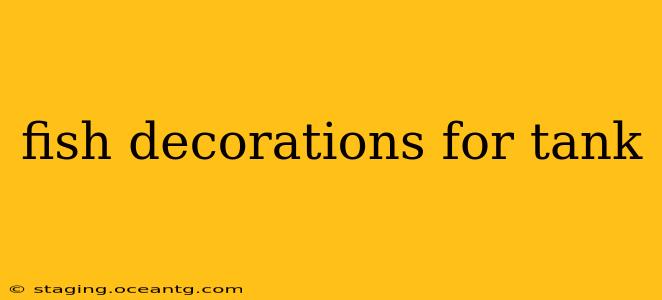Choosing the right decorations for your fish tank is crucial, impacting not only its aesthetic appeal but also the well-being of your aquatic companions. A well-decorated aquarium provides enrichment, hiding places, and a natural-looking environment that reduces stress and promotes healthy fish. This guide explores various options, considerations, and tips for creating a stunning and functional fish tank habitat.
What are the Best Fish Tank Decorations?
The "best" decorations depend entirely on your fish species, tank size, and personal preference. However, several popular options consistently provide both beauty and function:
-
Live Plants: These offer numerous benefits, including oxygen production, water filtration, and natural hiding places. Java moss, Anubias, and Vallisneria are excellent choices for beginners. Remember to research specific plant needs before adding them to your tank.
-
Driftwood & Rocks: These natural elements add visual interest and provide shelter. Driftwood can also contribute to water chemistry, adding tannins that soften water and create a more natural look. Make sure any wood is properly cured before introducing it to your tank to prevent leaching harmful substances.
-
Artificial Plants & Decorations: A cost-effective and low-maintenance alternative to live plants, artificial options come in a vast array of styles and colors. Choose high-quality, non-toxic materials to ensure your fish's safety.
-
Caves & Hiding Places: Fish often appreciate secluded areas to rest and feel secure. These can be made from ceramic, resin, or even creatively arranged rocks. The size and type of hiding place should be appropriate for your fish species.
What Decorations Should I Avoid in My Fish Tank?
Certain decorations are best avoided due to potential harm to your fish:
- Decorations with sharp edges or small parts: These could injure your fish.
- Decorations made from toxic materials: Always check for materials that are safe for aquatic environments.
- Decorations that are too large or occupy excessive space: Ensure your fish have ample room to swim.
- Decorations that shed paint or chemicals: These can pollute your tank water.
How Many Decorations Should I Put in My Fish Tank?
The number of decorations is a balance between visual appeal and functionality. Too few decorations can create a barren environment, while too many can overcrowd the tank and hinder cleaning. A good rule of thumb is to leave ample swimming space while strategically placing decorations to create visual interest and hiding places.
Are There Specific Decorations for Different Types of Fish?
Absolutely! The ideal decorations significantly depend on the species you keep. For example:
- Betta fish: Bettas appreciate ample surface space and areas to hide, like caves or plants with dense foliage.
- Cichlids: Some cichlids are territorial and may benefit from rock formations and caves for establishing territories.
- Corydoras catfish: These bottom-dwelling fish often appreciate smooth, rounded decorations and sandy substrate for digging.
What are the Best Materials for Fish Tank Decorations?
Safe materials are crucial for the health of your fish. Look for decorations made from:
- Ceramic: Durable and generally safe.
- Resin: Provides versatility in design, but ensure it's non-toxic.
- Glass: Inert and easy to clean.
- Natural materials (wood, rock): Ensure proper curing and cleaning.
How Do I Clean Fish Tank Decorations?
Cleaning decorations is essential for maintaining water quality. Remove decorations regularly and clean them with a soft brush and dechlorinated water. Avoid harsh chemicals.
By carefully selecting and placing decorations, you can transform your fish tank into a vibrant, enriching, and visually stunning underwater paradise for your aquatic friends. Remember to prioritize safety and choose decorations that suit both your aesthetic preferences and the specific needs of your fish.
